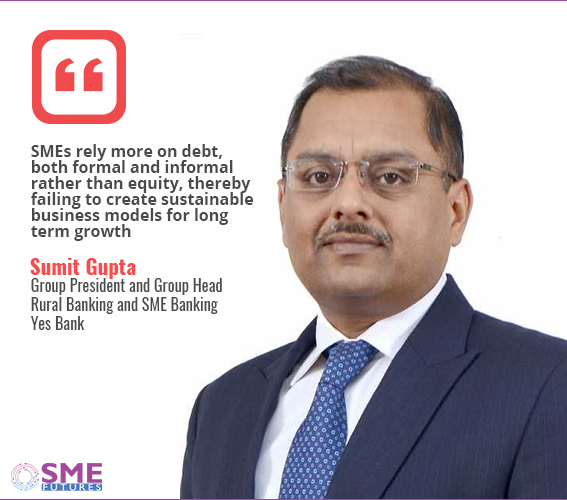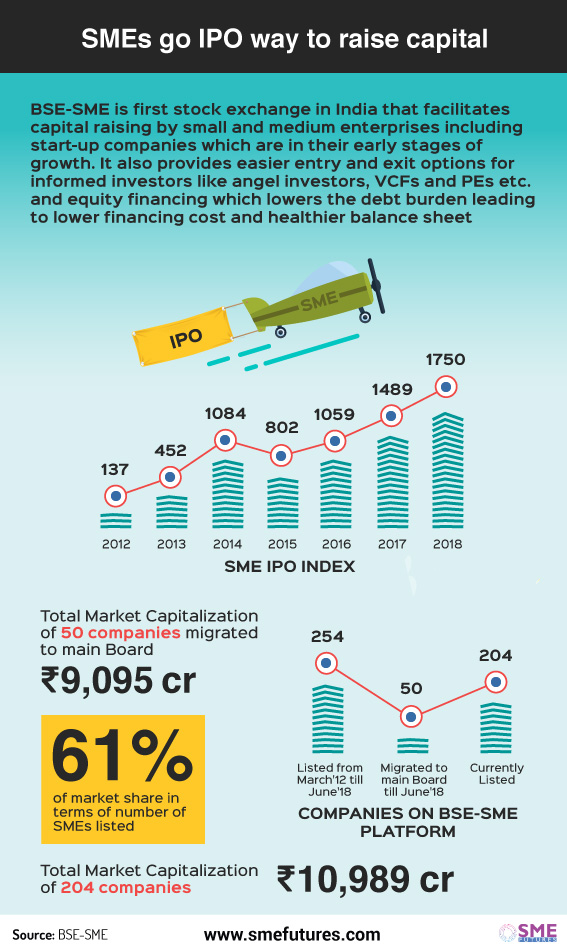Small and Medium Enterprises (SMEs) have undeniably done their bit when it comes to employment generation, contribution to GDP as well as social development and poverty alleviation. However, time and again, the sector’s lack of access to capital has been one of the biggest impediments for it to realise its full potential.
Statistics prove the importance of SMEs in Indian economy. According to Economic Survey (2017-18), they contribute 40 per cent to India’s export revenue, 42 per cent to industrial production and almost 13 per cent to the country’s GDP. Above all, they provide employment opportunities and entrepreneurship avenues to approximately 117 million skilled and unskilled workforce, often at a capital cost lower than those provided by large industries.
According to World Bank, more than half of India’s industrialisation is still to happen in the next 20 years and SMEs are going to be contributing almost 55 per cent of that industrial growth. For that to happen, SMEs should create job opportunities for 300 million workforce. This single fact itself points to the inevitable need to have a strong, enabling policy environment for SMEs to flourish. Access to available pool of capital is being quoted as one of the biggest enablers for rapid SME growth and thus helping the country in achieving the zenith of economic growth and all round development.
A big concern
Sadly, SMEs, more often than not, are starved for adequate funds and are faced with many challenges in raising capital both by debt and equity routes. Historically, a big gap has existed between capital requirement and their actual availability when it comes to SMEs. Government intent and industry’s initiatives notwithstanding, there have been some persistent teething problems. Measures like tax breaks, interest subvention schemes, though welcome, have often proved to be short sighted in terms of their overall impact and have contributed little towards improving the prospects of SMEs productivity.
The biggest and the most critical challenge, which has often been difficult for SMEs to surmount is the lack of access to requisite capital and resources. Even after 70 years of Industrial Policy (released in 1948) which for the first time propounded the need for establishment of SMEs, almost 87 per cent of SMEs still suffer from inadequate access to capital and are self financed. In addition to operational challenges, the very existence of many SMEs is often at risk as their collateral by nature is of low value. They require a dedicated line of credit, at least in their formative years till they reach a stable phase of operation and start accruing profits.
On the other hand, big corporate houses do not have any difficulties in acquiring funding. Saurabh Jhalaria, CEO of lending platform InCred, accounts several reasons for why SMEs lag behind in securing funds. “Most SMEs operate in the informal economy and sourcing data and proper financials are difficult and are often unreliable. Most of them are averse to paying taxes which result in reported financials not being credit-worthy,” he says.
Small size and local presence can also affect the chances of getting money from the bank. “Small businesses are mostly self-funded or exist through personal borrowing, as there is lack of information and knowledge about the various options available to them. To mitigate credit risks, banks typically look for enhanced collateral or traditional equity, both of which cannot be brought in by most entrepreneurs. Further, due to their small size and local presence, the transaction costs involved in financing them are very high, unless technology plays a key role in reducing costs and time to raise funds,” adds Jhalaria.

Not so rosy
The reasons why SMEs struggle for capital are varied. In a market where other industry counterparts seem to be having an easier access to capital, SMEs find it hard to lay their hands on the finance pool. Low collateral value of SMEs, unavailability of adequate finance with banks due to twin balance sheet issues, laggardness on the part of banks and financial institutions to bridge the credit gap, different and varied lending priorities according to whims and fancies of government of the day, non supportive regulatory environment, lack of financial knowledge among SME owners are often cited as the reasons why SMEs can’t raise the much needed capital.
“Despite the significant potential that the segment holds in driving India’s economic growth, SMEs have historically faced challenges in getting access to timely and cost-efficient financing. Often they have limited financial documentation since they have been operating primarily in the informal economy,” says Sumit Gupta who heads rural and SMEs banking at Yes Bank.
“They may have limited expertise in financial planning and cash flow management, which may result in non-compliance of regulatory requirements. Due to these reasons, SMEs end up relying heavily on private funds from family and friends. Most of these sources lack clarity and transparency and often carry very high implied rates of interest. As per the economic survey for 2018, SME advances stood at Rs 4.4 trillion which is 17 per cent of the total credit outstanding. There is large unmet credit demand in this segment, which is estimated to be about Rs 25 trillion,” adds Gupta.
Almost 60 per cent SMEs depend on internal funds, mostly from friends and family. This gap is more alarming if the informal SMEs and micro enterprises are taken into account. Without access to funding, the growth of SMEs tend to stagnate. It is a matter of utmost concern to note that three-quarter of SMEs in India lack access to a dedicated credit mechanism, the gap, in absolute credit terms, is to the tune of Rs 4 trillion. This has resulted in SMEs looking at informal sources of lending like private moneylenders who often charge exorbitant interest rates, upwards of 30 per cent on an average. Often entrepreneurs have no other option than to opt for such finance sources to meet their working capital demands.

Moreover, even as it is hard to get investment from banks or NBFCs, familial small businesses often see investors as outsiders and thus avoid them. They can feel possessive about their ownership. “Most family owned businesses often do not prefer any kind of ownership dilution. SMEs rely more on debt, both formal and informal rather than equity, thereby failing to create sustainable business models for long term growth,” says Gupta.
The ownership and control of family firms typically involve stronger emotional attachments to the firm due to total or partial merging of two institutions – family and the firm. “The possibility of conflict between insiders and outsiders often drives the familial businesses’ decision to not open up their ownership structure to outsiders. The SME businesses are typically passed on from generation to generation as a family business and the moment an outside investor start guiding the business, they consider that the business might go away from the hands of their next generation,” says Jhalaria. The other reason is the local expertise, which the promoters consider as their forte and believe that the investor will never be able to understand the nuances of their business and will create hurdles in day-to-day running of the operations, adds Jhalaria.
To address this mounting difficulty, the government launched SME Exchange in 2012 to provide an investor friendly platform for raising capital which can be utilised efficiently for meeting needs of expansion, technology replacement and diversification. As of date, only 207 companies are listed on the exchange: the government needs to increase awareness through focused marketing efforts. With technology advancements, business environment is getting more complex and if SMEs have to survive this disruptive wave they will have to make sound financial decision by maintaining a right mix of debt and equity.

That said, family businesses can also get benefit from private equity firms’ expertise in the areas of strategic planning, corporate governance and financial management. Most private equity firms maintain relatively small portfolios, so they can invest significant resources in engaging their companies and working with them on value creation and long-term planning.
A good start
There have been notable efforts by both central and state governments to cater to the financial needs of SME sector. They have put in place a framework to mentor SMEs in their jurisdictions. The focus is particularly on credit availability and boosting credit worthiness of SMEs.
Schemes like Credit Linked Capital Subsidy, Credit Guarantee Trust Fund for Micro and Small Enterprises (CGT-MSE), Technology Upgradation Fund Scheme, Micro Units Development & Refinance Agency (MUDRA), etc., have tried to bridge the gap between finance seeking SMEs and capital sources. In particular, CGT-MSE facilitates loan provision upto Rs 2 crore without the need for a collateral from the borrowing SMEs. Also, Non Banking Financial Companies have been roped in to be an additional lending partner in this endeavour.
An increased corpus allocation and budgetary support notwithstanding, there has been a noteworthy gap between demand and supply of finance through the government schemes. Recently, at the annual meet of Confederation of All India Traders held in Delhi, small business owners gathered from different cities discussed their difficulties in getting funds – they pointed out how banks were denying them MUDRA loans.
One size fits all approach for the eligibility of SMEs for various schemes acts as a hurdle. Each SME is at a different stage of product cycle, needing funding to meet different requirements. “Under different, industry-wise, cluster-wise, geography-wise schemes, government has tried to remove these hurdles but fact remains that only a few are able to get the real benefit of these schemes. Though the percentage exposure to SME sector has grown exponentially, growth rate in amounts and accounts of SME credit might be in imbalance owing to the reasons that banks have enhanced credit and extended government schemes like CGT-MSE to their existing clients to increase their outstanding amount but are not targeting new entrepreneurs into their fold,” says Jhalaria.
There is a need to provide varied options for financing SMEs, which they can choose according to their needs, so that they can be more resilient to disruptive changes. These solutions and policy directions should be persistent enough so that a clear roadmap may be laid out to revolutionise the way SMEs are financed in India. Only such facilitation shall make them competent enough to handle an increasingly disruptive world.
Performance and credit reporting systems
Benchmarking the performance of SMEs is essential to let them know their viability in terms of credit worthiness and market value. This is also essential for SMEs to track their performance vis-a-vis their counterparts in other fields. With the emergence of Big Data, multiple data sources can be effectively collated and analysed to come out with credit risk assessment.
The SME ministry has launched a Performance & Credit Rating Scheme, which extends a subsidy of a maximum of Rs 40,000 to SMEs who get themselves rated. Government has also launched a specialised rating agency – SME Rating Agency of India Limited – exclusively for SMEs. Ratings not only help SMEs to improve their creditworthiness and give them access to formal finance channels, but also act as one of the risk mitigation tools for banks’ in their credit evaluation process and ultimately provide SMEs with a smoother credit line.
Talking about how ratings can support the sector, Gupta of YES Bank informs about the initiatives and focused strategies adopted by the bank to ensure smoother flow of credit: “For micro enterprises, YES Bank has created a lending programme that assesses creditworthiness with bank statements and does not require financials. For small and medium enterprises, we have built a credit score card lending tool using statistical techniques to create a suitable lending framework. The score cards benefit SMEs by improving access to credit and helps YES bank to improve operational efficiency. In addition, we have also launched a programme to facilitate bank loans to woman borrowers for setting up green field enterprises.” In addition to this, YES Bank has also launched YES GST to help India’s small enterprises become GST-enabled.
Specific policy interventions are immediately required not only to improve capital access to SMEs but also in streamlining dedicated finance avenues, from which SMEs can unlock capital, maintain their dynamism and expand horizons innovatively as per the needs of an ever changing global economy. Provision of stable and multiple avenues of financing helps both the financing institutions as well as the borrower.
Way forward
Ensuring financial inclusion for a sector as important as SME requires a multi- pronged approach and requires empowerment of SMEs in the truest sense. Instead of policies that cater to SMEs’ financing needs in bits and pieces, an end to end approach must be followed to make available a suite of financial products through the SMEs entire lifecycle. This must be done on two fronts simultaneously – enhancing access to credit, and at the same time diversifying financing options.
A policy framework must be developed wherein both banks and alternative lenders can collaborate with each other, as it is a win-win situation for both banks and SMEs. The inherent advantages of SMEs must thus be effectively leveraged through sound financing options and policies, so that SMEs can be more productive and efficient enough and can overcome knowledge and logistical challenges. SMEs are the life-breath of India’s “economic lungs” and its time they are provided with enough financial strength to enable them to get their due credit in India’s growth story.











